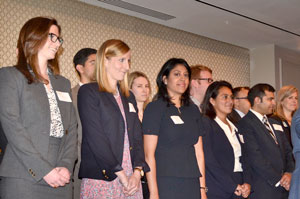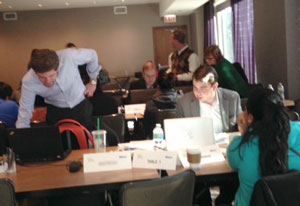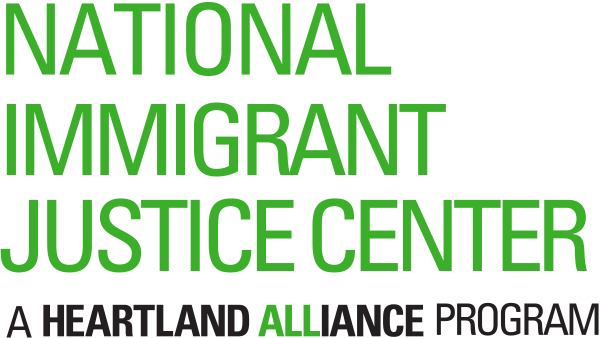Leveraging Volunteers: Recruiting, Training, Supporting and Retaining Pro bono Attorneys
By Lisa Koop & Ashley Huebner1
Legal services providers are encouraged by funders and other stakeholders to engage pro bono attorneys on matters ranging from simple intakes to complex litigation. Pro bono attorneys can add great value when they have the support of experts in the immigration field. Determining when, where, and how to involve pro bono partners can exponentially increase an organization’s impact. At the same time, if pro bono programs are not structured and maintained, they can detract from the organization’s work and leave everyone dissatisfied.
Programs must consider the strengths and limits of pro bono attorneys. While it is important to facilitate a positive and effective representation experience for both the client and the pro bono attorney, an organization must avoid providing technical support to such a degree that inefficiencies abound. A parallel goal for the organization is to avoid “boomerang cases” that are returned to the organization because the pro bono attorney-client relationship disintegrates. Implementing a pro bono program where all participants have positive experiences is first and foremost important for clients. However, pro bono attorneys and their firms can be long-term legal partners and are also potential financial donors to the organization and cultivating these relationships also may lead to broader support.
Here are best practices for recruiting, training, supporting and retaining pro bono attorneys:
1. Recruit strategically. Consider targeting attorneys who are uniquely positioned to handle children’s cases. These might include attorneys who:
A. Participated in law school clinics as students, who may bring legal foundations and familiarity with client care issues that are likely to arise when representing a child;
B. Have handled more limited pro bono matters and may have developed the confidence and interest to take on more complex matters. Note, however, that the effort to transition pro bono attorney involvement from more limited matters (like DACA applications) to more complex matters (like asylum cases) sometimes backfires, as firms often appreciate the shorter and less involved commitment of smaller cases and may be less willing to tackle lengthier and more complex cases. Some organizations have found it useful to invite potential pro bono attorneys to attend master calendar hearings or participate in outreach to children at immigration court to familiarize attorneys with the types of clients and issues involved in pro bonorepresentation.
2. Identify pro bono attorneys with the resources to manage the cases that need to be placed. Pro bonoattorneys often bring enthusiasm, great skill sets, and passion to UIC cases. When deciding which type of case to place with a particular pro bono attorney, ensure that resources available to the attorney reflect the requirements of the case. For example, asylum matters can be labor- and resource-intensive and, depending on case posture, may take years to resolve. They may require interpreters, country condition experts, forensic medical exams, etc. SIJS cases, on the other hand, may be more manageable in terms of time and resources. It is important to accurately communicate to pro bono attorneys the time and resources cases may require. Often, legal service organizations are unable to offer meeting space, interpretation, or secretarial services to their pro bono attorneys. For these reasons, many nonprofits limit placement of larger matters – like asylum cases – to larger firms with significant resources.
Given the rate at which attorneys change jobs, ensure that firms will transition cases to other attorneys within the firm if the pro bono attorney assigned to a case leaves. The firm should consider the pro bono client to be a client of the firm and not just of the individual pro bono attorney. If an attorney from a firm with whom the organization has not previously worked requests a pro bono matter, the nonprofit should have a conversation with the firm’s pro bonocoordinator or a senior partner regarding expectations before placing the case with the attorney.
For organizations that elect to place cases with small firms or solo practitioners, be sure to screen pro bonoattorneys. While large firms perform this function when hiring, smaller offices may not. Confirm identification, licensure, and good standing by checking with the relevant state bar. Legal services organizations may wish to request references and/or conduct background checks to ensure that children are being placed with safe and competent counsel.
 3. Cultivate “super volunteers.” Outreach to potential pro bono attorneys is often difficult for legal services providers, who are hampered by a lack of familiarity with firm pro bonoprograms and culture. Some of the most effective recruitment happens from within the firm, when a successful pro bono attorney shares her experience with colleagues, demonstrates that the work is manageable, and attests to the support she received from the placing organization. These “super volunteer” ambassador attorneys are valuable both because they tend to be repeat volunteers and because they recruit their colleagues. They stand out because they have worked well on pro bono cases and demonstrated enthusiasm for the work. They are often mid-level associates who have enough seniority and firm familiarity to feel comfortable promoting pro bono work. NIJC identifies these pro bono attorneys and celebrates their achievements through “Rising Star” awards distributed at its annual fundraising luncheon. Often, these “super volunteers” can be tapped to help identify new pro bono attorneys and also to accept new matters which may be more complex or present unique challenges. They may also serve as pro bono mentors.
3. Cultivate “super volunteers.” Outreach to potential pro bono attorneys is often difficult for legal services providers, who are hampered by a lack of familiarity with firm pro bonoprograms and culture. Some of the most effective recruitment happens from within the firm, when a successful pro bono attorney shares her experience with colleagues, demonstrates that the work is manageable, and attests to the support she received from the placing organization. These “super volunteer” ambassador attorneys are valuable both because they tend to be repeat volunteers and because they recruit their colleagues. They stand out because they have worked well on pro bono cases and demonstrated enthusiasm for the work. They are often mid-level associates who have enough seniority and firm familiarity to feel comfortable promoting pro bono work. NIJC identifies these pro bono attorneys and celebrates their achievements through “Rising Star” awards distributed at its annual fundraising luncheon. Often, these “super volunteers” can be tapped to help identify new pro bono attorneys and also to accept new matters which may be more complex or present unique challenges. They may also serve as pro bono mentors.
4. Define roles and responsibilities. Legal services organizations must ensure that prospective pro bono attorneys understand their role and the role of the placing organization. For example, some providers ask their pro bonoattorneys to sign an agreement which states that the provider is a consulting expert, privy to case information and available for case strategy input. NIJC asks its pro bono attorneys to sign a set of guidelines outlining NIJC’s expectations of the pro bono attorney as well as NIJC’s training and support. NIJC pro bono attorneys agree to attend an NIJC training, adhere to the scope of work defined by NIJC, retain the matter at the firm for the duration of the case, and communicate with NIJC staff about case developments. In turn, NIJC offers technical assistance and support to pro bono attorneys throughout the course of representation.
There may be times when a legal services organization seeks pro bono involvement in matters in which it lacks expertise, such as in the state court proceeding of SIJS cases. In these cases, the placing organization must clarify that it will not provide expert support, and that the request to pro bono counsel is to cover a gap in the organization’s legal expertise. For a good example of this type of pro bono partnership, see “The Minnesota Experiment” below.
5. Conduct case screenings and craft effective case descriptions. Legal services organizations placing pro bonocases must complete thorough case screenings and convey comprehensive case information to pro bono attorneys, especially because children’s cases often are procedurally complex. Investing in good intake practices is likely to minimize confusion and frustration later. NIJC, for example, begins asylum intakes with a brief telephone screening, followed by an in-depth, in-person intake interview conducted by a trained intake worker. The intake worker follows a list of questions intended to gather the information required to determine asylum eligibility. The intake worker supplements the interview with country condition research. The intake worker then presents the case to a supervising attorney, who typically asks additional questions for the intake worker to explore with the potential client. Once all the information is collected, the supervising attorney makes a case acceptance determination. If accepted, the intake worker drafts a case description that includes the essential facts, procedural posture, significant legal hurdles, and impending deadlines of the case as well as the country of origin, current location, and language of the client. The case description should flag all critical issues so that the pro bono attorney is not surprised by any issues after case acceptance. These case descriptions are circulated to potential pro bono attorneys for possible pro bono placement.
6. Ensure the client understands the role of the pro bono attorney. The legal services organization should explain the concept of pro bono representation to clients orally during the intake process and through documents – like retainers – issued to clients following case acceptance. Pro bono involvement is most useful to legal services organizations when the relationship between the pro bono attorney and the client is firmly established and the placing organization is removed from most aspects of representation. The aim of the legal services organizations should be to provide ongoing training and support to the pro bono attorneys, guide case strategy determinations, and share legal and procedural updates. Placing organizations should promote direct communication between pro bonoattorneys and clients. Once the placing organization has assigned a pro bono attorney to a client, it should resist serving as a conduit for communication between the two. Some organizations recruit and train volunteer interpreters to assist pro bono attorneys who may not speak the client’s language, while others require pro bono attorneys to secure their own interpreters. Regardless of how the organization seeks to overcome language barriers, a primary goal must be to ensure that clients understand their roles, their attorneys’ roles, and the role of the nonprofit.
7. Devote sufficient resources to pro bono support. Organizations placing pro bono matters should have a designated pro bono coordinator who is the main point of contact, available to respond to inquiries from pro bonoattorneys within one working day. Several leading UIC legal representation organizations have rejected pro bonoassistance models because they lack resources to support a viable pro bono program. For nonprofits that use pro bono models, providing pro bono support can be a full-time job for one or more staff members. Typically, pro bonosupport involves providing in-depth legal trainings, offering consultations by phone or email to discuss case strategy, working through client interaction issues, identifying experts and interpreters, monitoring upcoming hearings and interviews, and reviewing case filings, such as affidavits and legal briefs. In addition, a regular audit of all pro bonomatters, including a check-in with the pro bono attorneys, should be part of any pro bono model.
8. Remove obstacles for pro bono attorneys. Byvirtue of being legal services organizations connected to the community, placing organizations may be better-positioned to respond to some issues that arise in UIC representation. While the aim of most pro bono placements is to encourage the pro bono attorney to handle the heavy lifting involved in representation, organizations should be ready to assist when doing so would promote efficiency and would be likely to retain the pro bono attorney as a future volunteer. For example, though NIJC tells pro bono attorneys that it is their responsibility to identify interpreters for their clients, NIJC maintains a list of volunteer interpreters to support its pro bono partners. The cost to NIJC of maintaining this list is minimal and the benefit of offering pro bono attorneys this assistance is significant. Similarly, when clients of pro bono attorneys have social service needs, the legal services organization is often best-positioned to make referrals. Additionally, legal nonprofits can facilitate pro bono representation by providing pro bono attorneys with self-help materials like quick reference guides and frequently asked question sheets that allow pro bono attorneys to quickly access information. Some NIJC samples are located online.These tools provide the added benefit of reducing pro bonoinquires to the organization, which maximizes the capacity of everyone involved.

9. Avoid “failure to launch” situations. The outsetof a pro bono attorney-client relationship is a critical time during which many promising case placements fizzle. Pro bono attorneys may be daunted by the responsibility and unfamiliarity of matters they have accepted. Clients are intimidated both by the process and the prospect of sharing intimate details of their cases with new counsel. While good pro bono attorney training and support, combined with strong and clear client intakes can help minimize some of these challenges, placing organizations should consider other models to support the positive launch of these relationships. One option is to borrow clinic models from other contexts, where the organization trains attorneys and immediately introduces them to their clients at the training location. The legal servicesorganization also may conduct a brief orientation with clients while the attorneys are receiving legal training to reiterate the nature of the pro bono representation and prepare clients for their meetings with their attorneys. While matters involving immigr
ant children almost never will be completed during one attorney meeting, facilitating the first attorney-client meeting will overcome many of the challenges that can be the downfall of a case. An alternative approach is to have a legal worker from the placing organization attend the initial pro bono attorney-client appointment at the pro bono attorney’s office to facilitate introductions, orient the client to the meeting location, and clearly signal to the client that the transition in representation has occurred. Through these efforts, the risk of the attorney losing momentum and delaying initial contact with the client is removed; as is the possibility of client unresponsiveness. Following a face-to-face meeting, both parties will be more invested in the continued success of their relationship. Legal services organizations can ensure that all parties involved leave the meeting with clear next steps and assignments to ensure ongoing communication between the parties.
Leveraging pro bono involvement can significantly increase the impact of a legal organization seeking to provide representation to immigrant children. Dedicating the time and resources necessary to train and support attorneys can ensure clients receive high quality services and that the programs are sustainable.
1. Lisa Koop is the associate director for legal services at the National Immigrant Justice Center. Ashley Huebner is the managing attorney for NIJC’s Asylum Project.
|
|

